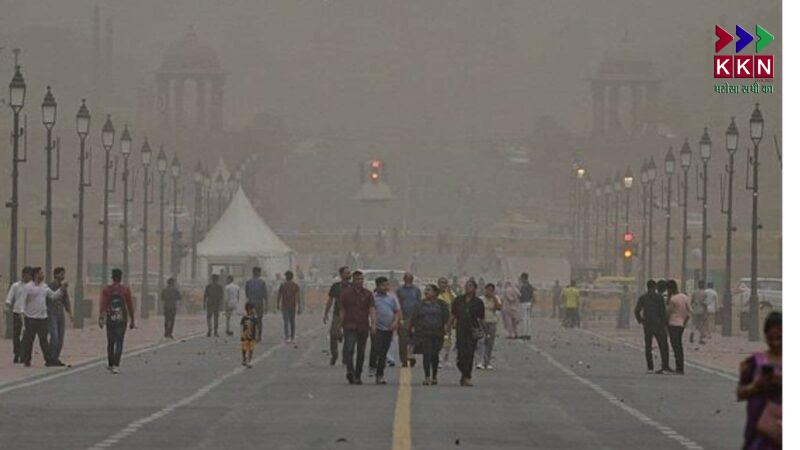
Delhi and the National Capital Region (NCR) continue to struggle with severe air pollution, particularly following the Diwali celebrations. The city is currently experiencing toxic air quality levels, with the Air Quality Index (AQI) reaching alarming figures. The situation remains critical, especially in areas like RK Puram, where the AQI has soared to 380, falling under the ‘very poor’ category. This rise in pollution is attributed to the smoke from fireworks during Diwali, as well as seasonal factors such as smog and fog. The pollution levels in Delhi remain a growing concern for its residents and pose a serious health risk.
Current Air Quality in Delhi: Severe Pollution After Diwali
On the second day of Diwali, Delhi- NCR is still grappling with air pollution. The air quality continues to be in the ‘very poor’ category, according to data released by the Central Pollution Control Board (CPCB). The AQI across Delhi is currently fluctuating between 345 and 380, indicating dangerously high pollution levels. Areas like RK Puram have reported an AQI of 380, reflecting a serious environmental health hazard. The presence of toxic pollutants like particulate matter (PM 2.5) in the air is alarming, contributing to the poor air quality across the city.
Despite the ongoing air quality crisis, the government has imposed the implementation of GRAP-2 (Graded Response Action Plan) to combat the worsening pollution. However, this action has not yet significantly improved the situation, and it is expected that Delhi will continue to face poor air quality in the coming days.
GRAP-2 and Its Impact on Pollution Control
Given the alarming levels of air pollution, the authorities have activated GRAP-2 in Delhi. GRAP-2 is a part of a multi-phase plan that aims to control pollution through stringent actions. This includes regulating construction activities that produce dust and imposing restrictions on diesel generators, except for essential services, to curb harmful emissions. By enforcing these measures, the government hopes to reduce the intensity of pollution and protect the health of residents, particularly vulnerable groups such as children, the elderly, and people with respiratory issues.
However, the effectiveness of GRAP-2 remains uncertain, as the pollution levels in Delhi continue to hover in the ‘very poor’ category. The central and local authorities will need to enhance these measures to bring down the pollution levels in the coming days.
Air Quality Across Delhi and NCR
According to the CPCB’s data, the AQI across various parts of Delhi is currently very concerning. Areas such as ITO, Akshardham, and India Gate are witnessing AQI readings of around 361 to 362, which places them in the ‘very poor’ category. These high AQI readings indicate a serious environmental crisis affecting public health. Local residents of Delhi are feeling the effects of poor air quality as they experience shortness of breath, irritation in the eyes, and reduced visibility, especially during early morning walks or cycling.
A local resident, Shailendra Ray, who was cycling along Kartavyapath on Wednesday morning, mentioned that the air quality worsens post-Diwali, primarily due to the smoke from crackers and the reduced visibility. Despite this, he stated that the situation was similar every year, with no major health issues at the moment. He expressed that while the air quality is poor, those who venture out early morning experience less trouble compared to those going out later in the day when visibility and pollution levels tend to worsen.
Worst Affected Areas in NCR: Ghaziabad, Noida, and Haryana
The pollution crisis is not just limited to Delhi; the NCR region is also facing severe air quality problems. In Ghaziabad, the AQI has reached 324, categorizing it as ‘very poor’. Other areas like Noida and Hapur have recorded AQI readings of 320 and 314, respectively, placing them in the same hazardous category. In Haryana, regions like Narnaul and Rohtak have seen AQI readings of 390 and 376, while Gurugram and Bahadurgarh’s AQI has reached 370 and 368, respectively. These figures indicate a worsening situation across the entire NCR region.
In Rajasthan, Bhiwadi recorded an AQI of 364, while in Gujarat, Nandesari registered an AQI of 303. These alarming AQI figures reflect the widespread impact of pollution not just in Delhi but across neighboring areas as well.
Challenges in Combating Pollution: Low Expectations for Relief
The weather department has indicated that there is little hope for immediate relief from the pollution in Delhi and NCR. The AQI is expected to remain within the ‘very poor’ to ‘poor’ category in the coming days. This situation is a matter of concern for the millions of people living in the region, as the air quality continues to deteriorate, posing health risks to the population.
Every winter, Delhi faces a pollution crisis, driven by factors such as vehicle emissions, stubble burning, and dust. These pollutants accumulate in the atmosphere, creating a toxic haze that affects more than 20 million people in the city and its surrounding areas. Last week, the Supreme Court allowed the sale and bursting of green crackers during Diwali, relaxing the ban on firecrackers to some extent. However, this measure did little to address the larger problem of air pollution in the region.
Understanding AQI Standards and Categories
The Air Quality Index (AQI) is a system used to measure and report air quality levels. It is categorized into different levels, with each level indicating the severity of the pollution and its potential impact on health. Here are the AQI categories and their corresponding meanings:
Good (0-50): Air quality is considered satisfactory, and air pollution poses little or no risk.
Satisfactory (51-100): Air quality is acceptable; however, some pollutants may cause minor discomfort for a small number of people.
Moderate (101-200): Air quality is acceptable; however, some people may experience health effects.
Poor (201-300): Air quality is unhealthy for sensitive individuals, including those with pre-existing respiratory conditions.
Very Poor (301-400): Health effects are likely to be more severe, especially for people with respiratory issues.
Severe (401-500): Health warnings of emergency conditions. The entire population is likely to be affected.
Currently, areas like RK Puram, ITO, and Akshardham in Delhi are experiencing AQI levels in the ‘very poor’ category, which poses significant health risks.
Impact of Pollution on Health: Urgent Need for Action
The continuous pollution in Delhi has a direct impact on the health of its residents. Exposure to poor air quality, especially during the winter months, increases the risk of respiratory diseases, eye irritation, and cardiovascular problems. Vulnerable groups, including children, the elderly, and people with pre-existing health conditions, are at a higher risk of experiencing serious health effects.
Authorities have been taking steps to mitigate the pollution, but the efforts have not been sufficient to resolve the ongoing crisis. The GRAP-2 implementation is one of the key steps in addressing the problem, but more comprehensive measures are needed to bring lasting improvements.
The situation in Delhi and NCR remains dire, with pollution levels reaching alarming levels post-Diwali. While the implementation of GRAP-2 is a step in the right direction, it is clear that more robust and long-term solutions are necessary to tackle the city’s pollution problem effectively. The health of millions of people is at risk, and urgent measures are required to protect the environment and public health. Only with comprehensive action can Delhi hope to overcome this environmental crisis and improve the quality of life for its residents.
Share this:
- Click to share on WhatsApp (Opens in new window) WhatsApp
- Click to share on Facebook (Opens in new window) Facebook
- Click to share on Threads (Opens in new window) Threads
- Click to share on Reddit (Opens in new window) Reddit
- Click to share on Telegram (Opens in new window) Telegram
- Click to share on X (Opens in new window) X
- Click to share on LinkedIn (Opens in new window) LinkedIn


